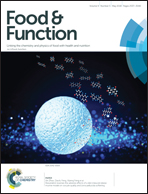Fabrication and characterization of complex nanoparticles based on carboxymethyl short chain amylose and chitosan by ionic gelation
Abstract
We aimed to investigate whether the combination of the modification of short chain amylose (SCA) with chitosan (CS) through the electrostatic interaction could be considered as a candidate for oral delivery of bioactive ingredients. Carboxymethyl short chain amylose (CMSCA) was synthesized by reacting SCA with monochloroacetic acid. The changes in SCA levels after the reaction were investigated by zeta-potential determination, Fourier transform infrared (FTIR) spectroscopy, differential scanning calorimetry, thermogravimetry and derivative thermogravimetry. Complex nanoparticles (NPs) were then synthesized using CMSCA and CS by ionic gelation. FTIR spectral analysis revealed that the complex NPs were synthesized by hydrogen bonding and electrostatic interactions between CMSCA and CS. CMSCA/CS NPs show an insulin encapsulation efficiency of 85.2% and exhibit sustained release of insulin in vitro. CMSCA/CS NPs were observed to show excellent cytocompatibility by cell culture. These findings demonstrated that CMSCA/CS NPs constructed by the ionic gelation method could be further exploited as a potential oral delivery system for peptide drugs.



 Please wait while we load your content...
Please wait while we load your content...